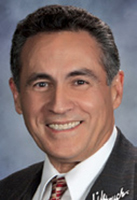
Executive Perspective
Challenges to Some Long-Running Traditions
BY DANIEL A. DOMENECH/School Administrator, October 2020

THE TOPIC FOR this month’s School Administrator is teaching, learning and districtwide change. What an incredibly appropriate theme for these COVID-19 regulated times.
My daughter is a 6th-grade teacher. She has transitioned from full-time face-to-face instruction to being an online instructor. She is a Millennial so the pivot to remote teaching was a welcome addition to her teaching repertoire. That has not necessarily been the case with older instructors, individuals like me, whose technological savvy does not extend much beyond the ability to turn on and off a personal computer.
As many school districts transitioned to remote learning, either full time or part time as in the blended models, the training of teachers to effectively instruct in this format has become a priority. Many districts brought in their staffs well before the beginning of instruction to provide them with the training that would ensure this round of remote leaning would be more effective and efficient than what occurred during the final quarter of the last school year when, without warning or preparation, schools closed their doors and the only option was remote instruction.
Even so, teachers, administrators and school support staff must be commended for their efforts to provide food to their students, stay in touch with them and their families and provide instruction as best they could.
As teaching adapts to the new environment, so will learning. In the remote environment the students will need to take on greater responsibility for their learning. For some students this will be a welcomed development because it means they will have greater say in what they want to learn and when. For others, without the teacher in the room to keep them on task, they may not be as engaged in the process as they need to be.
Balancing Approaches
As school districts consider the various models to reopen schools, some have prioritized those students most in need of in-person learning. Younger students in the K-3 range fall into that category, as do students with special needs and students for whom English is a second language.
Asynchronous instruction works well with the engaged students, but the less engaged students have a greater need for synchronous classes. The combination of both approaches is what most districts are offering or plan to offer as the school year proceeds, but teachers will need to assess their students’ needs to balance the right approach with each student. Instructors in personalized learning programs already have mastered that process as they have implemented strategies for their students to learn at their own pace.
To date, personalized learning has occurred mostly in the brick and mortar environment with the online component happening within the classroom under the watchful eye of the teacher, but the shift to remote learning or the hybrid model has been easier for the teachers and students who have worked in a personalized learning environment. Indeed, as we think about districtwide changes, the current situation presents districts with the opportunity to shift to this style of teaching and learning.
As we consider the learning loss that has taken place since school closures began, the challenge for school administrators will be to develop strategies to erase the loss. Remote learning affords opportunities to “catch up” in ways that may be more effective than traditional pullout or remediation strategies. Rather than having students repeat their grade level, as some have suggested, a better approach would be to assess where the student is at and proceed from there with a personalized learning approach. No need to go over competencies that the student already has mastered. Rather, instruction ought to focus on those competencies the student has not yet attained.
Tackling Traditions
We are seeing major changes to long-standing traditions such as the school calendar, seat time requirements and hours spent in school. Year-round schooling — popular some years ago as a way of dealing with overcrowded schools — might make a comeback. With the potential of repeated school closures due to COVID-19 infections in schools, an extended school year would facilitate making up lost time. An extended school year also could help with the learning losses of students who were unable to receive instruction due to the lack of computers and/or internet connection in the home. With hybrid models, the extended school year would allow for students to have more time with person-to-person instruction in the classroom.
If there is a silver lining to the pandemic, it may well be the opportunity to make changes that are long overdue.
DANIEL DOMENECH is AASA executive director. Twitter:
@AASADan